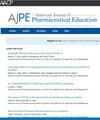An Investigation of College and School of Pharmacy Support for Graduates who Fail the NAPLEX
IF 3.5
4区 教育学
Q1 EDUCATION, SCIENTIFIC DISCIPLINES
引用次数: 0
Abstract
Objective
To determine the prevalence of Accreditation Council for Pharmacy Education (ACPE)-accredited colleges/schools of pharmacy (C/SOP) that support graduates who fail the North American Pharmacist Licensure Examination (NAPLEX) on their first attempt and, secondarily, to characterize the nature and determine the effectiveness of that support.
Methods
A 19-item electronic survey was designed to assess if and how C/SOP supports graduates who fail the NAPLEX on their first attempt and the perceived effectiveness of this support. The survey, which contained forced-response, Likert, and open-ended items, was distributed to 141 ACPE-accredited C/SOP. Subsequent-attempt pass rates were compared between C/SOP that reported providing (or not providing) support. Descriptive statistics, χ2, and t-tests were conducted.
Results
Fifty-eight C/SOP participated (41% response rate). The demographics and mean 3-year first-time NAPLEX pass rates among responding C/SOP were comparable to those of all ACPE-accredited C/SOP. While nearly all C/SOP (97%) acknowledged their responsibility in preparing students for the NAPLEX while enrolled, only 29% indicated supporting graduates who failed the NAPLEX on their first attempt. This was accomplished through the allocation of faculty/staff time and effort (76.5%) and access to college/school resources (64.7%). Those offering support deemed their process somewhat to very effective for improving subsequent-attempt pass rates; however, no difference was observed between C/SOP with or without established processes (57.5% vs 59.8%).
Conclusion
Few C/SOP have established support processes for graduates who fail the NAPLEX. Those providing support indicated it was effective; however, there was no correlation to better subsequent-attempt pass rates. While the onus of passing the NAPLEX falls to graduates, C/SOP may consider supporting those who fail the exam, time- and resource-permitting.
高校和药学院对全国大学生高考不及格毕业生的支持情况调查。
目的:了解acpe认可的药学院/学校(C/SOP)对第一次和第二次NAPLEX未通过的毕业生提供支持的普遍情况,并确定这种支持的性质和有效性。方法:设计了一项19项的电子调查,以评估C/SOP是否/如何支持第一次尝试NAPLEX失败的毕业生,以及这种支持的感知有效性。该调查包含强制回答、李克特和开放式项目,分发给141个acpe认证的C/SOP。随后的尝试通过率在报告提供(或不提供)支持的C/SOP之间进行比较。进行描述性统计、卡方检验和t检验。结果:参与C/SOP 58份,有效率41%。响应C/SOP的人口统计数据和平均3年首次NAPLEX通过率与所有acpe认证的C/SOP相当。虽然几乎所有的C/SOP(97%)都承认他们有责任在学生入学时为NAPLEX做准备,但只有29%的人表示支持第一次尝试NAPLEX失败的毕业生。这是通过分配教师/员工的时间/精力(76.5%)和获得学院/学校资源(64.7%)来实现的。那些提供支持的人认为他们的过程在一定程度上非常有效地提高了后续尝试的通过率,然而,在有/没有建立过程的C/SOP之间没有观察到差异(57.5% vs 59.8%)。结论:很少有C/SOP为未通过NAPLEX的毕业生建立支持流程。然而,那些提供支持的人表明它是有效的,与更好的后续尝试通过率没有相关性。虽然通过NAPLEX的责任落在毕业生身上,但在时间和资源允许的情况下,C/SOP可能会考虑支持那些没有通过考试的人。
本文章由计算机程序翻译,如有差异,请以英文原文为准。
求助全文
约1分钟内获得全文
求助全文
来源期刊
CiteScore
4.30
自引率
15.20%
发文量
114
期刊介绍:
The Journal accepts unsolicited manuscripts that have not been published and are not under consideration for publication elsewhere. The Journal only considers material related to pharmaceutical education for publication. Authors must prepare manuscripts to conform to the Journal style (Author Instructions). All manuscripts are subject to peer review and approval by the editor prior to acceptance for publication. Reviewers are assigned by the editor with the advice of the editorial board as needed. Manuscripts are submitted and processed online (Submit a Manuscript) using Editorial Manager, an online manuscript tracking system that facilitates communication between the editorial office, editor, associate editors, reviewers, and authors.
After a manuscript is accepted, it is scheduled for publication in an upcoming issue of the Journal. All manuscripts are formatted and copyedited, and returned to the author for review and approval of the changes. Approximately 2 weeks prior to publication, the author receives an electronic proof of the article for final review and approval. Authors are not assessed page charges for publication.

 求助内容:
求助内容: 应助结果提醒方式:
应助结果提醒方式:


